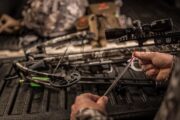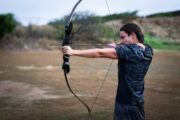If you’ve decided you need a lever action, congratulations on your choice to add a classic American firearm design to your gun safe, hunting adventures, and range time bliss. But do you know that finding such a rifle can be an overwhelming task, especially for a beginner?
How to Choose the Right Hunting Lever Action Rifle for You

When narrowing down your choices, pick a safe lever action rifle to take all your hunting and sport shooting aspirations to the next level. Here are some buying tips to follow before pulling the trigger on that lever-gun purchase.
Know Your Plan
Is hunting the main use of this gun? If so, how far away is it? Is it uncommon and meant for collection? Would you prefer a shotgun, centrefire, or rimfire? Knowing what ticks your boxes is the ultimate key to choosing the ideal lever action. The lever action rifle has long been associated with poor long-range performance, although guns like the Henry Long Ranger and Browning BLR have challenged this notion.
Take one of them in a calibre such as 6.5 Creedmoor, .308, or 243, and you’ll be sprinting across the 300-yard range in no time. Collectors of vintage classics like the Henry Original, Winchester 1895, Marlin, Winchester 1873, Yellowboy, and innumerable others will place varying values on condition, factory letters, and scarcity. Start the search with a rough idea of your desires, and the lever shopping world is your oyster.
Look Through the Diverse Calibre Selection
The next gap to fill is choosing the calibre of your most recent lever-action purchase after you’ve determined its intended use. The 30-30 Winchester, closely followed by the 32 calibres, may be the classic lever calibre, regardless of how much has altered over time. However, if the big and dangerous game is on the menu, the 45-70 Government should be at the top of the most common list.
On the other hand, what happens if you’re a collector who wants to adhere to the originals? Then, it’s challenging to put a collection together without an original 44–40 Victory. If you, however, consider doing some traditional brush blasting for deer, a Remington 35 is what you will need. The popularity of handgun calibres has skyrocketed, particularly with Henry Big Boy rifles.
Even though ballistics will limit the hunting range, bullets are more readily available and have a lower price due to their reduced recoil. For those hunters who like the most powerful large bores, Big Horn Armoury offers robust levers in calibres such as .500 S&W, .475 Linebaugh, and .500 Linebaugh. Finally, rimfires are the most widely used and reasonably priced levers.
For almost 150 years, lever-action rimfire repeaters have been offered for firearms such as the Winchester 1873.22 Short or.22 Long calibre. There are chambering’s available for .22 LR, .17 HMR, .17 HM2, and .22 WMR in contemporary production guns made by Henry, Winchester, Marlin, and other companies. This is only a starting point, of course, as there are many more chamberings to be found on both old and new lever action rifles.
Opt between Iron Sights and Scope

Part of deciding on your plan is considering whether you’d prefer to do the majority of your shooting with iron sights, an optic, or both. Most of the time, collectors will avoid optics in favour of looking for genuine weapons with the appropriate irons. When purchasing a lever action rifle Canada-wide that hasn’t been pre-drilled and tapped for an optics attachment, realistic shooters will probably need to hire a gunsmith or have specialised mounts to scope the weapon.
Even with factory weapons that come with sights, hunters frequently want better. There’s no better aftermarket sighting improvement available than the ones that can personalise your lever action, as well as provide peeps, front sights, expanded Picatinny rails, and more. Of all the iron sights, a nice peep is perhaps the easiest to get.
Consider Special Options
Take into account the special features and options as well. Select a rifle with an already-threaded barrel if you plan to use a suppressor. In this regard, some rifles are can-ready, meaning that the silencer does not need to be removed to charge the gun. Though it’s an area of constant debate, some lever gun lovers favour small loops while others, usually gloved shooters, want the biggest loop.
It is typically aesthetics, in general. Barrell length is one of the factors. Shorter carbine lengths will make you more manoeuvrable if you’re a brush-busting hunter. Shooters at a distance should look for longer possibilities. Half-round and half-octagon barrel options were available on the original Winchesters, and some manufacturers continue to make them.
Don’t Overlook Safety
Safety features on lever action rifles are a bit of a novelty these days; however, this was not always the case. Therefore, it’s critical to comprehend its operation if your rifle has one. Rather than completely stopping the hammer from descending, some models install a block that prevents the hammer from falling low enough to strike the firing pin and ignite the primer. However, it is the responsibility of each individual to test and understand how their own firearm operates when it comes to firearm safety.


